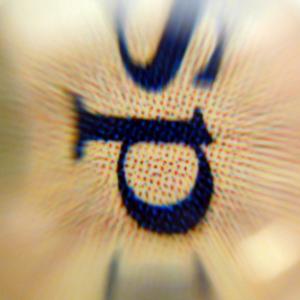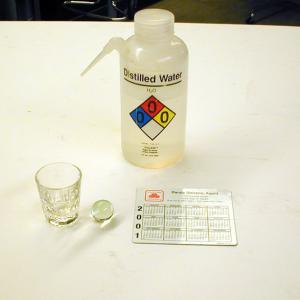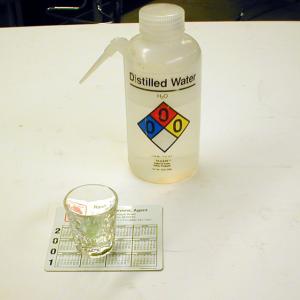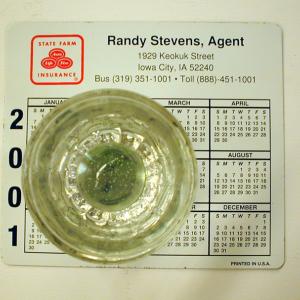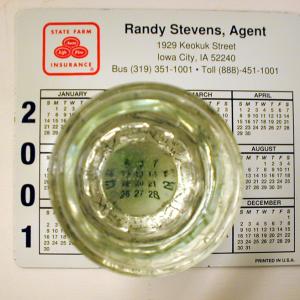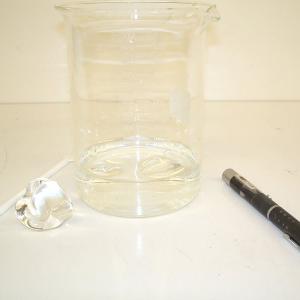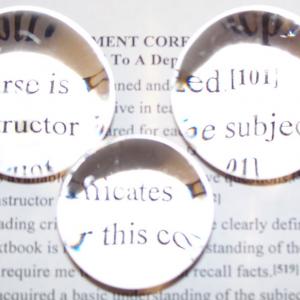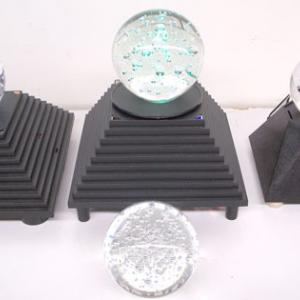College of Liberal Arts & Sciences
6A65.50 - Water Drop Lens - Oil Drop Lens
Place a drop of water onto the Plexiglas plate. Using this as a lens look at the writing on the flexible magnet.
Place one of the spherical lenses into a hole in one of the cards. Using this as a lens look at the writing on the flexible magnet.
Place the watch glass on the Bunsen burner stand with the curved side down. Place 10 or 15 mL of water into the watch glass. Using this as a lens look at the writing on the flexible magnet.
Place the shot glass onto the magnetic calendar and then place the glass marble into the shot glass. In this configuration you should not be able to read the numbers by looking through the marble because of the very short focal length. Adding water to the shot glass will increase the focal length and make the numbers recognizable.
Place several of the polyacrylamide polymer hydrophilic spheres in water over night. They will grow to a diameter of approximately 5 cm and have the same index of refraction as the water which will make them virtually invisible in the beaker. A single sphere can be used as a large water drop lens with large magnification.
- Matthew Stephen Neel, "Estimating the Refractive Index of a Hydrated Superabsorbent Polymer Sphere", TPT, Vol. 62, #4, April 2024, p. 262.
- Thomas B. Greenslade Jr., "The Spherical Lens Redux", TPT, Vol. 59, #7, Oct. 2021, p. 516.
- Jack Freeland, Venkata Rao Krishnamurthi, and Yong Wang, "Learning the Lens Equation Using Water and Smartphones/Tablets", TPT, Vol. 58, #5, May 2020, p. 360.
- Gordon Gore, "Inversion Redux", TPT, Vol. 54, #9, Dec. 2016, p. 576.
- Jair Lucio Pradps Riberio, "The Inverted Snow Globe Shadow", TPT, Vol. 53, #1, Jan 2015, p. 8.
- Luisa Bragalenti, Andrea Stefanini, and Gabriele Tassinari, "Correction: 'Water Pearls Optics Challenges for Everybody'", TPT, Vol. 52, #6, Sept. 2014, p. 327.
- Terrence P. Toepker, "Purkinje Images", TPT, Vol. 52, #3, Mar. 2014, p. 133.
- Luka Vidic and Miha Kos, "Squeezing Light", TPT, Vol. 50, #9, Dec. 2012, p. 570.
- Max Ziegler, "Galilean Refractor in an Aquarium", TPT, Vol. 50, #4, Apr. 2012, p. 251.
- Max Ziegler, "Correction: Max Ziegler, Overhead Projector in a Wastebasket'", TPT, Vol. 50, #4, Apr. 2012, p. 199.
- Marina Milner-Bolotin, "Water Pearls Optics Challenges for Everbody", TPT, Vol. 50. #3, Mar. 2012, p. 144.
- Max Ziegler, "Overhead Projector in a Wastebasket", TPT, Vol. 50, #1, Jan. 2012, p. 60.
- Walter Trikosko, "Physics in a Glitter Ball", TPT, Vol. 49, #2, Feb. 2011, p. 110.
- Martin Gardner, "Magic Jigger", TPT, Vol. 39, #5, May 2001, p. 302.
- Andreas Muller, "Sneezing, Pixel Spacing, and Geometric Optics", TPT, Vol. 36 #8, Nov. 1998, p. 509.
- V. Anantha Narayanan, Radha Narayanan, "Low-Cost Homemade Liquid-Lens Refractometer", TPT, Vol. 34, #5, May 1996, p. 300.
- Jim Shaw, "Ray Optics With A Spherical Surface", TPT, Vol. 30, #4, Apr. 1992, p. 218.
- Eugene P. Mosca, "Only Two Rays?", TPT, Vol. 30, #7, Oct. 1992, p. 388.
- Roger E. Malcolm, "Fluid Lenses", TPT, Vol. 27, #8, Nov. 1989, p. 636.
- Thomas B. Greenslade Jr., "The Spherical Lens", TPT, Vol. 25, #7, Oct. 1987, p. 431.
- John B. Johnston, "Water Lens", TPT, Vol. 11, #2, Feb. 1973, p. 114.
- D. Rae Carpenter Jr. and Richard B. Minnix, "O-330. Saran and Ring Stand", DICK and RAE Physics Demo Notebook, 1993.
- G. D. Freier and F. J. Anderson, "Og-11", A Demonstration Handbook for Physics.
- Robert Ehrlich, "10.5. A Water Lens", Why Toast Lands Jelly-Side Down, p. 161.
- Robert Ehrlich, "Spinning a Water-Filled Cylinder", Turning the World Inside Out, p. 66 - 67.
- Robert Ehrlich, "10.6. A Rotating Water Lens", Why Toast Lands Jelly-Side Down, p. 162.
- "Water Beads", National Geographic Kids, 50 Fun Experiments for the Mad Scientist in You, p. 77.
- "Seeds Sprout in Water Beads", National Geographic Kids, 50 Fun Experiments for the Mad Scientist in You, p. 24.
- George M. Hopkins, "Microscopy", Experimental Science, p. 278.
- George M. Hopkins, "Mirrors", Experimental Science, p. 208.
- Pat Murphy, Ellen Macaulay, and the staff of the Exploratorium, "Droplet Lenses", Exploratopia, p. 297.
- Martin Gardner, "9. The Magic Glass", Smart Science Tricks, p. 21.
- Martin Gardner, "Magic Picture", Entertaining Science Experiments with Everyday Objects, p. 69.
- Janice VanCleave, "38. Water-Drop Microscope", Teaching the Fun of Physics, p. 62.
- "Soda Straw Magnifying Glass", Physics From the Junk Drawer, 3rd Edition, The Science House, North Carolina State University, p. 48.
- "Oil Drop - Oil on Water", Physics From the Junk Drawer, 3rd Edition, The Science House, North Carolina State University, p. 49.
- "Waterdrop Microscope", Laser Classroom.
Disclaimer: These demonstrations are provided only for illustrative use by persons affiliated with The University of Iowa and only under the direction of a trained instructor or physicist. The University of Iowa is not responsible for demonstrations performed by those using their own equipment or who choose to use this reference material for their own purpose. The demonstrations included here are within the public domain and can be found in materials contained in libraries, bookstores, and through electronic sources. Performing all or any portion of any of these demonstrations, with or without revisions not depicted here entails inherent risks. These risks include, without limitation, bodily injury (and possibly death), including risks to health that may be temporary or permanent and that may exacerbate a pre-existing medical condition; and property loss or damage. Anyone performing any part of these demonstrations, even with revisions, knowingly and voluntarily assumes all risks associated with them.

